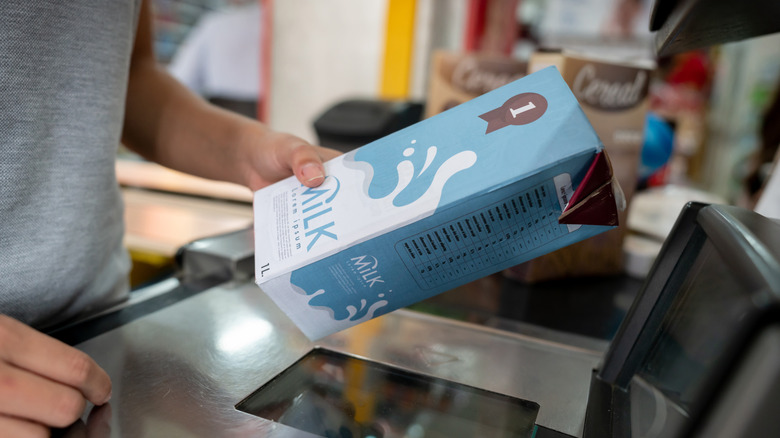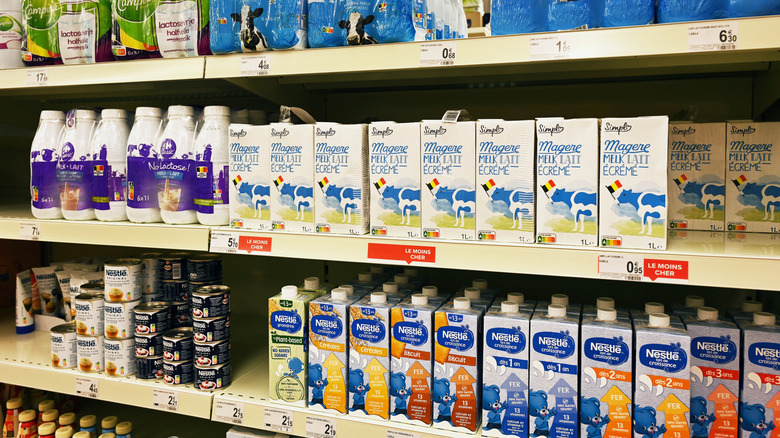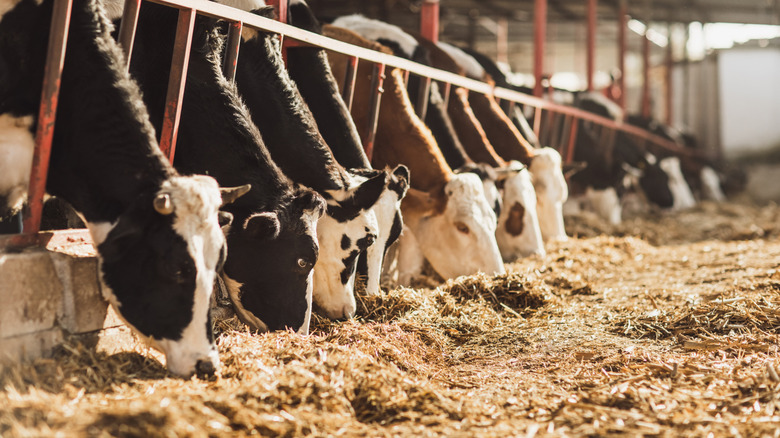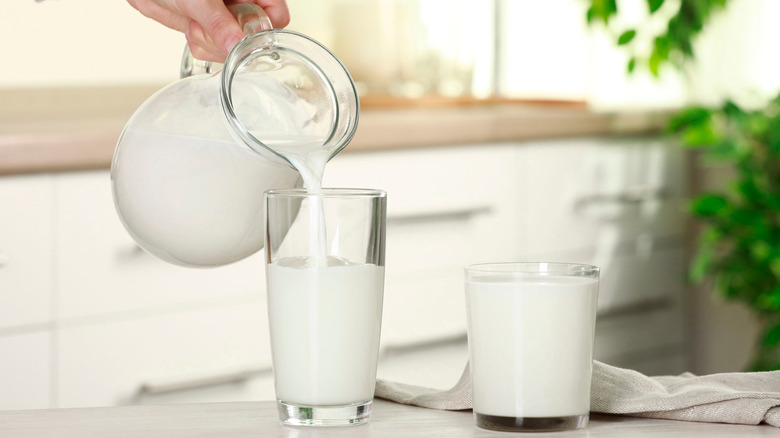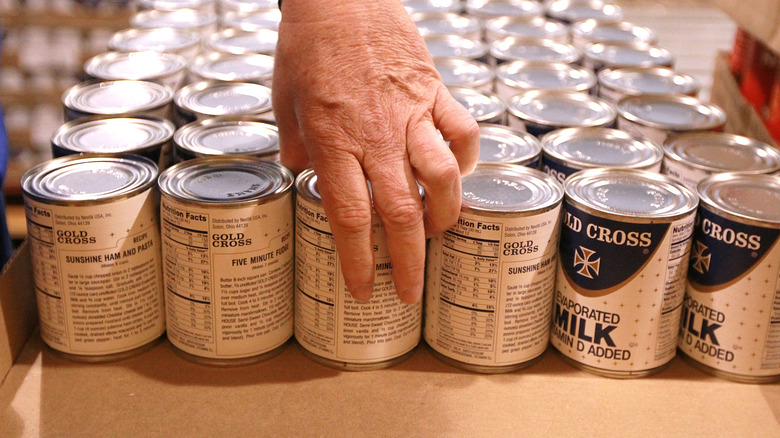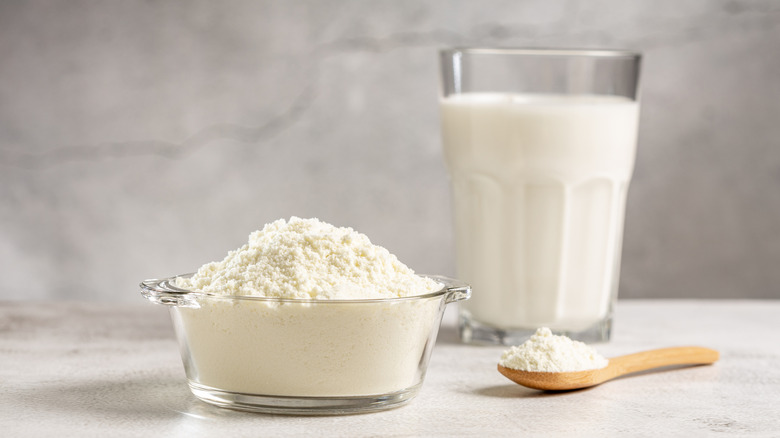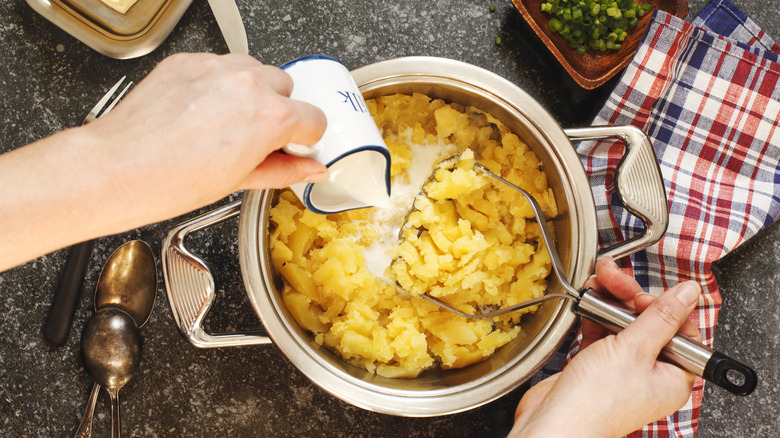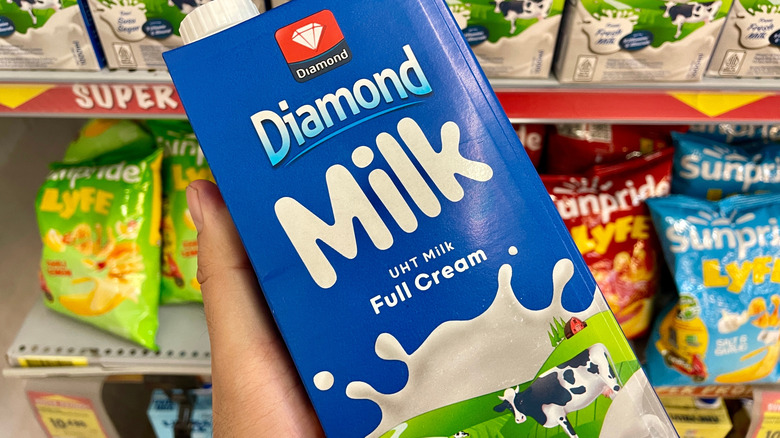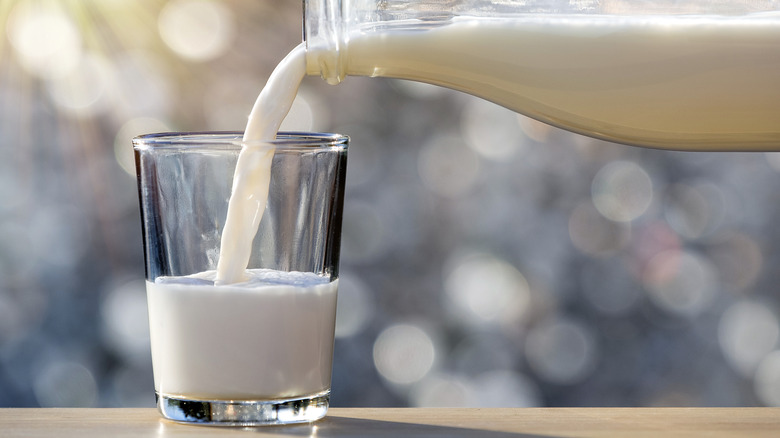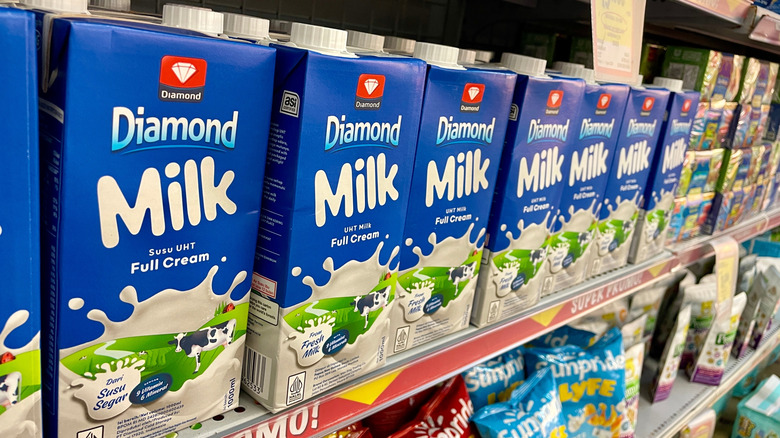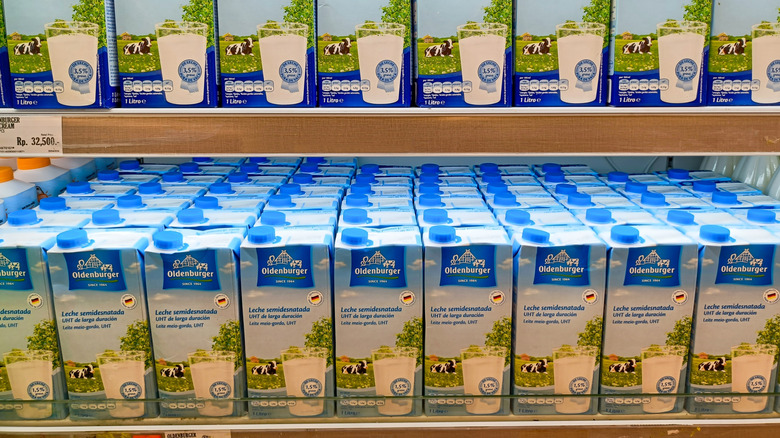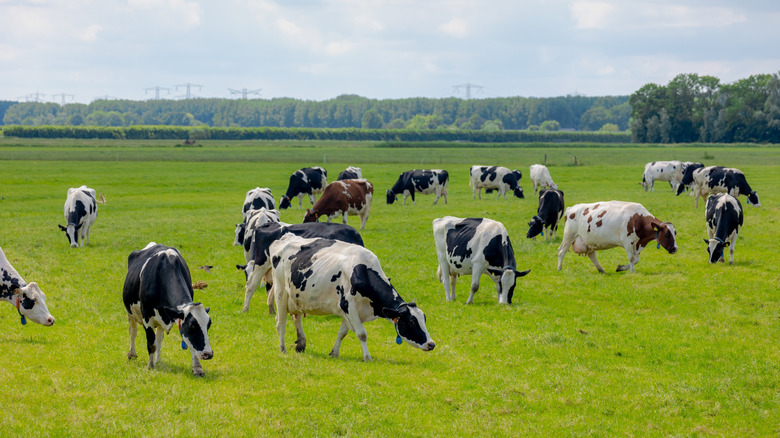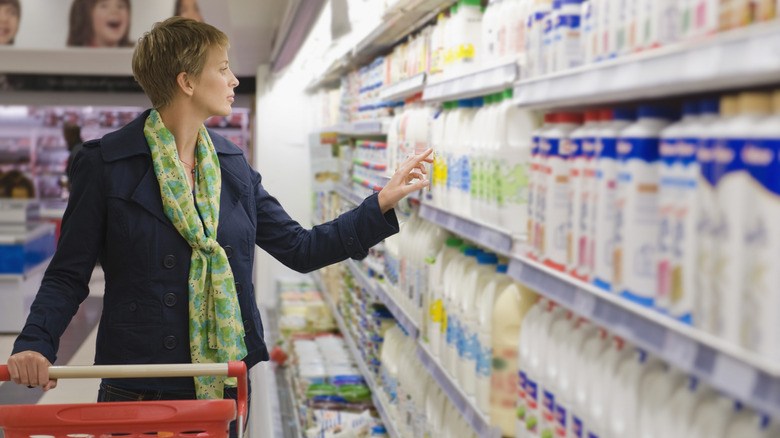What Is Shelf-Stable Milk And Why Doesn't It Need To Be Refrigerated?
We may receive a commission on purchases made from links.
Milk is an ingredient that can inspire strong emotions. Some people love drinking a glass of cold milk straight from the fridge, while others gag at the thought of it. Some have very particular tastes in non-dairy milks, while others will take really whatever you have on hand. Even the packaging can be divisive. Have you ever shown an American bagged milk? Confusion abounds.
However, for all our arguments about milk and how to package it, there's one type that often gets a little overlooked, simply because it's not all that popular in American households: shelf-stable milk. So what is it and why doesn't it need to be refrigerated? What magic has occurred that allows this milk to be shelf-stable and sit out on the grocery store shelf and then in your pantry for months on end? Is it even real milk? Here's everything you need to know about shelf-stable milk.
What is shelf-stable milk?
According to the U.S. Department of Agriculture's Food Safety and Inspection Service, shelf-stable foods and drinks must be able to be stored at room temperature, safely. They must also be treated via heat or a drying process. This ensures that foodborne microorganisms die off and cannot spoil the food or lead to a foodborne illness.
To further stabilize milk, though, most shelf-stable milk comes in aseptic packaging. The aseptic packaging process creates an extremely hygienic long-term food storage solution, as the packaging itself, the food going into the package, and the packing environment are all sterilized. Aseptic packaging is usually made from plastic and aluminum, and was originally developed to transport milk and water to disaster relief sites. Beyond milk and water, other foods that are commonly packaged in aseptic packaging include juice (think juice boxes!), wine, and broth. You likely already use aseptic-packaged products on a regular basis.
How shelf-stable milk is made
But how does the milk go from cow to box? There's really actually not that much difference between making shelf-stable milk and the type that requires refrigeration. So long as we're talking dairy milk, the milk comes from a cow, as normal.
Things differ when it comes to the pasteurization process. Normally, pasteurized milk is heated to 161 degrees Fahrenheit or hotter, for at least 15 seconds. This short heating process kills any bad bacteria. For shelf-stable milk, though, the manufacturer simply cranks up the heat a bit, using a process called ultra-high temperature pasteurization, or UHT pasteurization. The milk is heated to up to 300 degrees Fahrenheit, but for a shorter length of time: as little as two seconds. Then, of course, the pasteurized milk goes into its aseptic packaging, with every step of the process monitored to be as hygienic as humanly possible.
The differences between shelf-stable milk and regular milk
The primary difference you're going to notice between shelf-stable milk and regular, refrigerated milk, is the taste. Consumers note that many shelf-stable milks have a slightly "cooked" flavor profile, due to the ultra-high temperature pasteurization. As such, in terms of use, shelf-stable milk may not be as preferable as regular milk if you're just planning to drink it straight. However, many use shelf-stable milk for cooking and baking, and note no differences.
Nutrition-wise, there aren't really many differences, either. If you compare Horizon Organic's shelf-stable organic whole milk to Horizon Organic's refrigerated organic whole milk, both contain 10% of your daily recommended fat intake, 12% of your cholesterol, 16% of your protein, and 25% of your vitamin D. The one noticeable difference is in calcium, with the shelf-stable option providing 20% of your daily recommended intake, compared to the refrigerated option's 25%.
The differences between shelf-stable milk and canned milk
Canned milk comes in two varieties: evaporated and condensed. You probably know canned condensed milk for its use in a range of desserts, but you might not be as familiar with evaporated milk. When you heat regular milk until it loses the majority of its water content, it becomes evaporated milk. When you take this milk and then add a significant amount of sugar to it, it becomes condensed milk. Store-bought condensed milk is about half sugar by volume.
As such, when comparing shelf-stable milk and evaporated/condensed milk, you'll find the latter two options are much thicker. Shelf-stable milk has more water content, but it doesn't have any of the added sugar that condensed milk has.
You can use evaporated milk in place of boxed shelf-stable milk, but you'll need to add water to it to get the right consistency. Condensed milk isn't a good substitute for shelf-stable milk unless you want a particularly sweet substitute.
The differences between shelf-stable milk and powdered milk
Powdered milk is made by pasteurizing milk and then drying it until it can be crumbled into a powder. It is used in an array of commercially processed foods, such as candies, and it's also a favorite with bakers. It's also technically shelf-stable and can be stored for long periods of time.
When comparing powdered milk and shelf-stable boxed milk, one difference many notice is taste. While shelf-stable milk can taste a bit cooked due to the high heat pasteurization process, powdered milk can taste a little on the bland, watery side. Additionally, powdered milk is not as convenient as shelf-stable milk, as it does have to be reconstituted with water, whereas shelf-stable milk can just be opened and poured. Like shelf-stable milk, powdered milk doesn't have any major nutritional differences when compared to fresh milk. However, powdered milk may have less overall nutrients when compared to shelf-stable milk. When comparing Microingredients Whole Milk Powder to Horizon Organics' shelf-stable milk, the former offers more vitamin D, vitamin A, potassium, and riboflavin.
How to cook with shelf-stable milk
While you can use shelf-stable milk in just about any place you'd use regular, pasteurized milk, it's not always advised, due to the slight difference in taste. Instead, consider using the shelf-stable variant in dishes that don't rely on milk's flavor. For example, many use it in baking projects, such as brown butter cinnamon rolls. Dishes that cover up the taste difference with bigger, bolder flavors are also a good fit, such as macaroni and cheese or ranch-flavored mashed potatoes.
Because the milk has already been cooked to a greater degree than fresh pasteurized milk, it's not recommended to use it in dishes wherein you'll need to cook the milk even longer, such as in a creamy soup or milk-based sauce. Additionally, because of the high-heat cooking process and the way it kills even some of the good bacteria in milk, shelf-stable milk can't be used to make most cheeses (though it can be used to make yogurt, ricotta, and paneer).
Where to buy shelf-stable milk
You can buy shelf-stable milk at just about any grocery store. Shelf-stable milk is not usually sold in the refrigerated section, but near the breakfast foods, as well as in the baking aisle or near the dairy-free shelf-stable milks.
You can also buy shelf-stable milk online, via retailers like Amazon. There, you can find a range of options, including large, 32-ounce cartons, as well as shelf-stable milk in individual serving boxes, similar to juice boxes and outfitted with straws. Just like refrigerated milk, shelf-stable milk is sold in varieties such as whole, non-fat, low-fat, and flavored, with flavor options including vanilla, strawberry, and chocolate. Even Hershey's sells a shelf-stable chocolate milk.
Popular shelf-stable milk brands include Horizon Organic, Parmalat, and Carnation. More generally, though, you can buy a broader variety of shelf-stable milk in other countries, like France and Spain, where shelf-stable milk is more popular.
Shelf-stable milk nutritional information
Shelf-stable milk is very comparable, nutrition-wise, to regular, refrigerated milk. While the high-heat pasteurization process does remove some of the nutrients, it's not to a significant degree. You'll still get key nutrients from shelf-stable milk, such as protein and calcium. Servings of Great Value refrigerated whole milk and Prairie Farms shelf-stable milk both contain 8 grams of protein and 300 milligrams of calcium.
Some have hypothesized that shelf-stable milk increases the risk of cardiovascular disease. However, a 2017 study – "The effect of UHT-processed dairy milk on cardio-metabolic risk factors" published in the European Journal of Clinical Nutrition — found that ultra-high temperature-treated milk did not impact body weight, blood pressure, insulin, glucose concentration, or insulin resistance in any way different from refrigerated, fresh milk.
Most agree that both milks are pretty much the same when it comes to health benefits and risks. If you're not worried about health risks from refrigerated pasteurized milk, you shouldn't be worried about them from shelf-stable milk.
Nutrition differences in different types of shelf-stable milk
Just as there are different brands of refrigerated milk, there are also different brands of shelf-stable milk. Here's how a few differ, nutritionally.
Prairie Farms' shelf-stable whole milk comes with 140 calories, 8 grams of fat, 5 grams of saturated fat, and 8 grams of protein per 1-cup serving. The same serving size of Horizon shelf-stable whole milk comes with 150 calories, 8 grams of fat, 5 grams of saturated fat, and 8 grams of protein. The same serving size of Kirkland Signature's shelf-stable whole milk comes with 150 calories, 8 grams of fat, 5 grams of saturated fat, and 8 grams of protein.
So, if you're just looking at the same types of shelf-stable milk, and considering nutrition, there's no need to worry. You're pretty much getting the same nutrients across the board. The only time that will change is if you're buying whole versus fat-free or low-fat milk.
How long does shelf-stable milk last?
Shelf-stable milk will easily last for up to six months if stored in a cool, dry place, away from heavily fluctuating temperatures or bright light. Opt for a pantry versus a cabinet near the stove, for example, or a storage space in a garage or damp basement. After opening, use it within the week and store it in your refrigerator. If you accidentally leave your milk out, you can expect it to lose a day's worth of freshness for every hour it sits at room temperature.
But can you freeze your shelf-stable milk to make it last even longer? Freezing any milk can minutely change the appearance, texture, and flavor, but you can still freeze it without worrying about safety concerns. Just pop the milk into the freezer before it goes bad and freeze it in a new, plastic container since the original container may expand as it freezes and burst. Frozen milk lasts in the freezer for about three months.
Shelf-stable milk's environmental impact
Because shelf-stable milk is regular milk, the same environmental concerns apply. Dairy milk production contributes significantly to land loss, freshwater loss, eutrophication, and greenhouse gas emissions. In fact, it's estimated that dairy milk accounts for around 27% of the carbon footprint of the average European diet, according to a study published in Global Food Security.
That said, the dairy industry is adjusting to lower its environmental impact. Looking at the last 70 years, in the United States, it has reduced land use by 90%, feed use by 77%, and water use by 65%, according to the Clarity and Leadership for Environmental Awareness and Research center at UC Davis and a study published in the Journal of Animal Science.
Shelf-stable milk's unique environmental impact, though, comes from its packaging. Aseptic carton packaging uses approximately 60% less plastic than alternatives and can be recycled to make other products, including cartons, crates, and even roof tiles.
Benefits and downsides of shelf-stable milk
The benefits of using shelf-stable milk are pretty clear and straightforward. Shelf-stable milk is convenient and its long shelf life means that you can keep it on hand for months. Its stability also makes it convenient for emergency use and, as such, it's a favorite product for preppers. Additionally, shelf-stable milk has all of the nutrients and health benefits that come with refrigerated milk. While there are slight differences in both taste and texture, some people do actually prefer shelf-stable milk. Shelf-stable milk is also more convenient for situations wherein refrigeration is restricted.
In contrast, some find the taste and texture difference to be a big downside to shelf-stable milk. Furthermore, it's simply more expensive than refrigerated milk. For example, at Walmart, Horizon Organic's refrigerated whole milk sells for about $1.38 per pint, while Horizon Organic's shelf-stable whole milk in a carton sells for around $2.33 per pint — almost a whole dollar more.
Why don't most Americans drink shelf-stable milk?
Shelf-stable milk's major fanbase lies outside of the United States. According to The Atlantic, approximately 90% of commercial milk in Europe is shelf-stable, with nearly all of the milk sold in countries like France and Spain being shelf-stable milk. The product is also growing in popularity in Asia and Central America. In contrast, as of 2020, it only made up 3% of the milk market in the United States, despite flashy marketing campaigns, like those produced by Parmalat in the 1990s.
There are a few reasons for this lack of popularity and growth, but it's mostly because Americans by and large have very convenient access to refrigeration. There's no need for them to use a product that has a reputation for being both more expensive and less tasty. Due to this access, Americans often equate refrigeration with freshness, and freshness with superiority. As such, boxed, unrefrigerated milk seems less than ideal.
